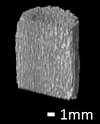Introduction: Temporal balance of "bone formation" and "resorption of materials" is extremely important for bioresorbable bone substitutes. In case resorption rate is too fast and bone formation is poor, the material would disappear and a bone defect would be remained. On the other hand, if resorption rate is so slow, the material would not be substituted for long time as is the case with non-resorbable ones.
It is known resorption rate can be controlled by adjusting material’s porosity. In addition, from a lot of studies, interconnected pore structure is suitable for bone ingrowth. We think unidirectional pore structure is particularly preferable for bone ingrowth because it doesn’t contain bottlenecks which inhibit cell migration and vascularization.
Therefore, we have newly developed a novel bone substitute; unidirectional porous beta-tricalcium phosphate (UDPTCP) by freeze casting method.
Materials and Methods: Slurry consisting of tricalcium phosphate and polymer solution was cooled in one direction to let columnar ice crystals grow parallel to the cooling direction. Then the frozen body was freeze-dried and sintered to obtain UDPTCP.

Cortical bone defects were created using a drill with 4mm diameter in the shaft of femur of a beagle (9-11 months old). UDPTCP was implanted in the defect as the direction of the pore was parallel to the axis of the femur. At 3, 6, 12 and 26 weeks after implantation, the tissue was harvested. For histological evaluation, undecalcified sections stained with toluidine blue method were prepared.
In addition, the repair process was investigated from a mechanical point of view. Compressive load was applied onto the UDPTCP implanted site using a compression testing machine equipped with a metallic jig of 4mm diameter.
Result & Discussion: UDPTCP has unidirectional pore structure in which the direction of the pore is parallel to a cooling direction. Porosity is approximately 57%. Compressive strength is 14 MPa for parallel to the pore direction.
From histological evaluation, new bone formation was observed 3 weeks after implantation. From 3 to 6 weeks, new bone volume increased and new bone reached the center of material in all specimens. Although material resorption gradually progressed, disappearance of UDPTCP was not observed before new bone formation. These results indicate UDPTCP served as a “scaffold” until new bone bridged a bone defect. At 26 weeks after implantation, UDPTCP was almost resorbed, and the substitution to a new bone was completed.

The compressive strength of implantation site gradually increased along with new bone formation inside the material. It was 79.6 MPa, 80.0 MPa, 91.1 MPa and 93.9 MPa at 3, 6, 12, and 26 weeks, respectively. The strength after 12 weeks is regarded as the level equal to a normal bone (94.1MPa).
Conclusion: From the test result, we think UDPTCP is useful as a bone substitute in beagle model, because its speed of the resorption balances with bone formation appropriately.